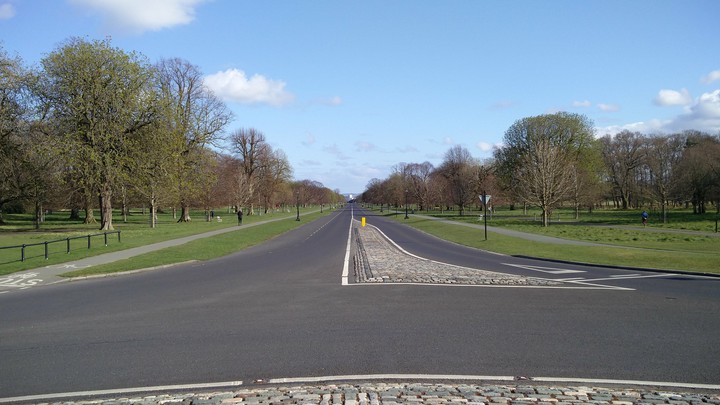Urban parks
 A quiet Chesterfield Ave during the first week of the lockdown (March, 2020)
A quiet Chesterfield Ave during the first week of the lockdown (March, 2020)
A 4.2 kilometre road cuts the 2000 acres of Phoenix Park neatly in half. Chesterfield Avenue doesn’t have a single pedestrian crossing, yield sign, or any amenity that isn’t designed for the car. During regular times, two lanes for the entire length serve as a parking lot. Throughout the park, pedestrians and cyclists have to stop and yield to passing cars. Its a strange hierarchy of movement to have within a park.
A pandemic-induced change saw the Office of Public Works (OPW) designate two lanes as cycle-only and closure of peripheral gates to vehicles - both steps that brought some measure of traffic calm. The new minister, in opposition to his own department by all accounts, reversed one of these decisions and so its back being a thoroughfare.
In all their public communication on why that is, a theme that stands out is their consideration for “An Garda Síochána and other key stakeholders”. In addition to being the largest walled park in Europe, the park is also home to several institutions. The residence of the Irish president and the U.S. Ambassador, the police headquarters, a hospital, a school, the zoo, cricket clubs, a polo ground, a visitor’s center, a nursing home, the Ordinance Survey of Ireland, several gatekeeper houses - some vacant, and a disused fort.
So OPW, it would seem in public, is balancing institutional needs with those of the general public. All this takes me to another place and another time.
The People’s Park
Hot and humid air welcome those arriving at Chennai Terminal train station. As transit planners the world over have trouble connecting dots, the nearest suburban train station is a short trek away in Park Station. For a long time, it was a bit of mystery to me why it was called Park Station as all around it was concrete and asphalt.
That sector of Chennai was the centre of British colonial power who built Fort St. George around the corner. So not to different from Phoenix park really. It was smaller of course, a mere tenth of its Dublin cousin.
What started in 1859 as a 22 acre park with several ponds and green spaces, slowly morphed in the century to follow. It grew to be as large as 112 acres at one point. The city council took over the park in 1866. Several acres were carved out in 1886 for the Victoria Public Hall - built to commemorate Queen Victoria’s golden jubilee.
Then there were stadiums and sports clubs followed by a convenient fire in 1985 that was the final nail. The small part of the park that does remain is virtually inaccessible by the public and in neglect.
So there you have it - a train station named after something that no longer exists. A cautionary tale on when government agencies serve each other rather than the general public. For Dublin, one can only hope that the 14 kilometre wall that keeps the deer in, keeps institutional needs out.